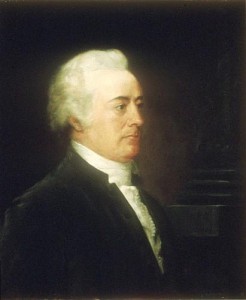 John Rutledge served as First Associate Justice of the first U.S. Supreme Court and was the Court’s second Chief Justice.
John Rutledge served as First Associate Justice of the first U.S. Supreme Court and was the Court’s second Chief Justice.
He was born in 1739 in South Carolina, where he became a successful lawyer as a young man. He quickly became a prominent member of the South Carolina general assembly, and later served as a delegate to the Continental Congresses. His brother Edward was the 31st signer of the Declaration of Independence. Rutledge helped write the U.S. Constitution, and worked to get it ratified. At the 1787 Constitutional Convention, Rutledge “supported slavery, argued that U.S. society be divided into official classes and believed that only landowners should hold government offices.” However, he vehemently objected to the notion that only landowners should have the right to vote, fearing that it would divide the nation into “haves and have-nots.”
George Washington,Rutledge’s main political sponsor, offered him a federal judgeship and appointment as minister to the Netherlands, which he declined. Rutledge very much wanted to be selected as Chief Justice of the first Supreme Court, but Washington chose John Jay for that position. Washington offered to appoint him as “First Associate Justice,” which he accepted, but he didn’t last long. The Court did not hear any cases during its first two years, but Rutledge had to travel great distances in “riding circuit,” which he hated. Because of the travel, poor health, and probably still upset that he was not appointed Chief Justice, he quit the Court in 1791 and returned to South Carolina, where he became Chief Justice of the Court of Common Pleas. The Supreme Court heard no cases during his tenure.
Though he resigned from the Supreme Court, he was still a national figure. In July of 1795 he spoke out “wildly” against the Jay Treaty,referring to it as a “prostitution” and declaring that the President should die rather than sign it. There were signs that Rutledge’s mental health was suffering since the death of his wife Elizabeth in 1792.
Washington was having some difficulty finding a replacement for Jay to serve as Chief Justice, further testament to the low regard to which the position was held at the time. Rutledge wrote to Washington expressing his interest, and Washington agreed, despite being aware of reports of his mental instability. Apparently he did not credit these reports and believed they were politically motivated. Washington nominated and named him as Chief Justice as a recess appointment in August 1795, pending Senate confirmation.
Rutledge, as acting chief justice, heard his only two cases, U.S. v. Richard Peters and Talbot v. Jansen.He wrote his only opinion in Talbot. Neither of these cases were noteworthy.
The Senate rejected his confirmation in December 1795,making him the first Supreme Court nominee not to be confirmed. It also marked the only time in U.S. history that a sitting Supreme Court Justice was involuntarily removed from office. According to The Yale Law Journal, Rutledge’s nomination was rejected “because they disliked his views on the role of the United States as a neutral party in the war between England and France.” There is no doubt that his outspoken denouncement of the Jay Treaty was a major factor in the Senate’s decision, but by then there was also increasing evidence that he was insane. John Adams noted Rutledge’s “accelerated and increased Disorder of the Mind.”
Upon hearing that his confirmation had failed,Rutledge attempted suicide by jumping off a wharf into Charleston Bay. Two passing slaves rescued him in an ironic twist, since he had been an outspoken supporter of slavery. Rutledge’s career was over. He was rarely seen in public again, and died in 1800.



